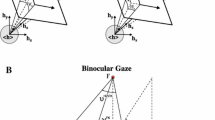Abstract.
This paper describes fast and accurate calibration-free adaptive saccade control of a four-degrees-of-freedom binocular camera-head by means of Dynamic Cell Structures (DCS). The approach has been inspired by biology because primates face a similar problem and there is strong evidence that they have solved it in a similar way, i.e., by error feedback learning of an inverse model. Yet the emphasis of this article is not on detailed biological modeling but on how incremental growth of our artificial neural network model up to a prespecified precision results in very small networks suitable for real-time saccade control. Error-feedback-based training of this network proceeds in two phases. In the first phase we use a crude model of the cameras and the kinematics of the head to learn the topology of the input manifold together with a rough approximation of the control function off-line. In contrast to, for example, Kohonen-type adaptation rules, the distribution of neural units minimizes the control error and does not merely mimic the input probability density. In the second phase, the operating phase, the linear output units of the network continue to adapt on-line. Besides our TRC binocular camera-head we use a Datacube image processing system and a Stäubli R90 robot arm for automated training in the second phase. It will be demonstrated that the controller successfully corrects errors in the model and rapidly adapts to changing parameters.
Similar content being viewed by others
Author information
Authors and Affiliations
Additional information
Received: 27 August 1996 / Accepted in revised form: 22 July 1997
Rights and permissions
About this article
Cite this article
Bruske, J., Hansen, M., Riehn, L. et al. Biologically inspired calibration-free adaptive saccade control of a binocular camera-head. Biol Cybern 77, 433–446 (1997). https://doi.org/10.1007/s004220050403
Issue Date:
DOI: https://doi.org/10.1007/s004220050403




